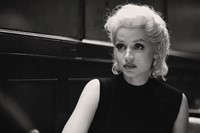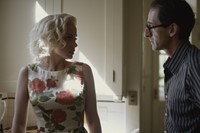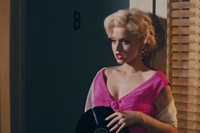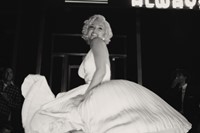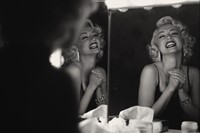Jennifer Johnson talks about revealing the person behind the myth, the “emotional armour” of Norma Jeane’s off-duty looks, and her thoughts on the Kim Kardashian dress controversy
Marilyn Monroe. An image embedded in our collective imagination, the woman embodying the golden age of Hollywood, the 1950s, the American dream. An emblem of 20th-century America as instantly recognisable as Coca Cola or white picket fences, an image that speaks to an era of deep gender inequality and objectification of women, but which we still can’t help fantasising about. Are we just being hypocrites? Or is there more to the ‘blonde bombshell’, the pinup model, the ultimate seductress to be fascinated about?
The image of Monroe has been so stereotyped by the industry that it is easy to forget there was a person breathing behind the brand; with his long-awaited biopic Blonde, Australian director Andrew Dominik surely wanted to bring the US icon’s humanity back. Recently presented at the Venice Film Festival, the film – based on Joyce Carol Oates’ book of the same name – is an intense, emotional and disturbing fictional journey into the inner lives of Norma Jeane Baker and her alter ego.
For costume designer Jennifer Johnson, revealing the complexity of the person behind the myth was the biggest challenge in her work on Blonde. Here, she reflects on how she brought life to some of the 20th century’s most iconic looks – and the “emotional armour” of Norma Jeane’s off-duty looks.
Valeria Della Valle: The core of the film is the dichotomy between Norma Jeane, the traumatised woman, and Marilyn Monroe, the Hollywood bombshell; Norma Jeane was represented in a sort of simple and pure uniform – black turtlenecks and Capri pants, versus the glamorousness of the public figure.
Jennifer Johnson: There are so many layers to her. She was an incredibly intelligent, articulate, well-spoken person who was interested in so many things. She wanted to be taken seriously and that’s part of what that uniform is: it’s a very intellectual way of dressing, very European. Think about Godard or the Beat poets of the 50s. That uniform is extraordinarily important as it represents a sort of emotional armour and it’s a statement about the person she really was and how she wanted to be acknowledged – as an intellectual person of interest, an artist. It was important to get that architecture right, because that carried her through so much of the film.
VDV: Second and third-wave feminists have come to embrace Marilyn as a modern-day feminist, a symbol of many battles against abusive behaviour and gender inequality.
JJ: There is this scene in the film, you know, when she asks her agent how much she was paid for Gentlemen Prefer Blondes and finds out Jane Russell would be making way more than her, despite Monroe being the blonde in the title! So, she hangs up the phone, furious. This really happened. She knew her worth and to voice out those aspects in the film was significant. For me, that’s an extremely important scene, something I could relate to as well. As costume designers, we are largely female, and we have our own pay parity and pay equity issues with other heads of department, you know.
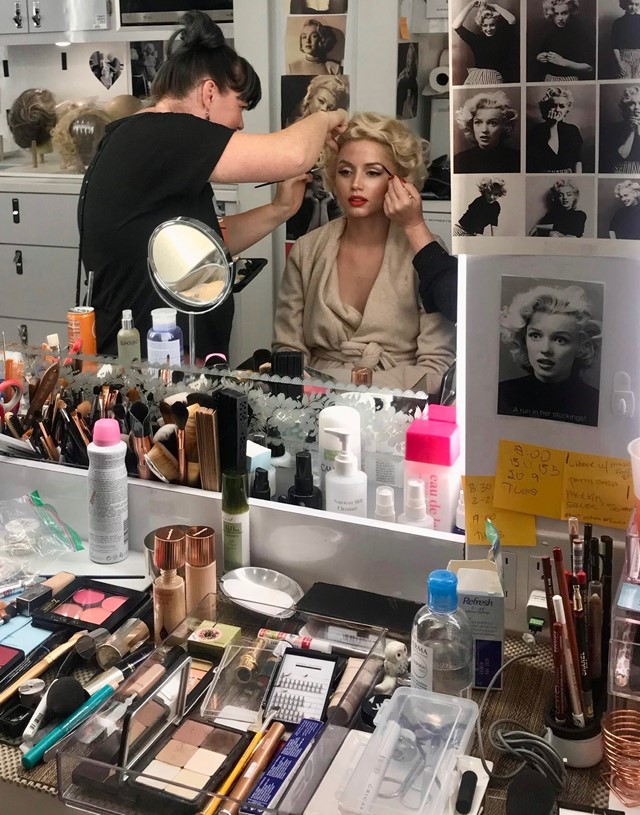
VDV: Was the stereotyping of the icon the biggest challenge to overcome?
JJ: With an icon like Marilyn Monroe, the risk is to be cheesy and cheap. The biggest challenge of recreating Marilyn comes from the fact that we are all so familiar with her. The whole world has seen her image somewhere, watched her films, even dressed as her for Halloween. It’s almost as if she belongs to all of us. How do you keep Norma Jeane’s spirit within each scene? There are shortcuts you could take when making and designing the costumes or reinterpreting the original designs because you can simply take a photo and copy it. We had a very small budget and a fast production, so the trick was to avoid those shortcuts because if you take them, and you don’t dig deep into the forensic work of how complicated the image was to create in the first place, you’re left with a sort of a cheapening of her – which we see when we walk on Hollywood Boulevard and see an impersonator in the white dress that blows up in the subway.
VDV: How do you breathe emotional life to such iconic costumes?
JJ: It has been very important to work not only based on the character itself but respecting the role of Ana de Armas, who plays Marilyn, and how the design should fit her body. Working with Ana to help her have her own experience with the designs, to achieve her own transformation and ability to own those costumes. It’s so easy in biopics to feel very academic, so you need to pay attention to the actor to make sure that everything becomes a living document.

VDV: It’s more about the way she was wearing those looks, how she made them come alive.
JJ: Exactly. Like when [Ana] was walking down the steps singing Diamonds Are a Girl’s Best Friend in the pink dress we all know. We felt something was wrong, like she was wrapped in a toilet paper tube, it didn’t have any life to it. So we went back to the drawing board and worked on the architecture to figure out how to electrify it and focus on the movement. We were working from an 800-page bible that Andrew Dominik had put together for over ten years, and the goal was to animate those costumes and give the fabric its own life.
VDV: As a professional in the field, what’s your take on the debate around Kim Kardashian wearing the iconic birthday dress at the Met?
JJ: It’s such a huge responsibility, you know. There is a great lack of conservation in costume in general. A lot of sketches of historical costumes have been thrown away over many decades. Debbie Reynolds, for instance, had a huge costume collection, including the ruby slippers. She tried to make a museum to keep it together, but no one was interested.
I thought Kim looked amazing, but why not recreate it, like we did? In my opinion, because that dress is a singular entity and it’s so important to Marilyn’s history, it shouldn’t leave a curatorial, air-conditioned, temperature-controlled environment. This is the same with all the vintage clothing. Next time she can call me, and I’ll make one for her [laughs].
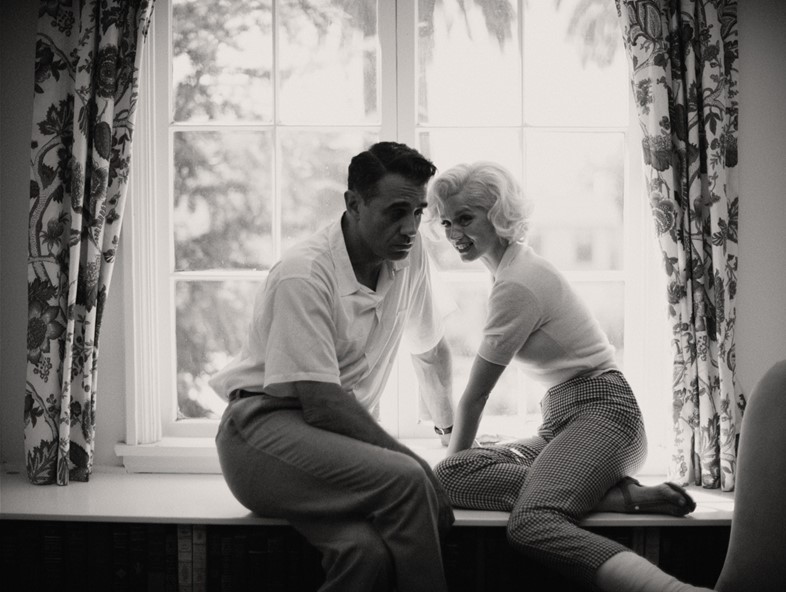
VDV: Which looks were the most challenging to recreate?
JJ: The dress she wears in Some Like It Hot when she’s singing with the band was one of the most difficult and satisfying to recreate. Surprisingly, the hardest one to make was the white pleated dress in The Seven Year Itch. That was very technical, and there are only a few people in the United States who know how to work those old ways of pleating. There’s one guy in LA, whose father had also made a recreation of this dress for Universal Studios and kept doing it for them, so we had to relearn how to not do it that way. For the [original] pink dress of Gentlemen Prefer Blondes, William Travilla had to remake the original design last-minute to be more modest after the leaking of some pics of Marilyn posing naked for a calendar. He couldn’t find a fabric to back the dressing and [make it] heavier, so he went up to the art department at Fox Studios and found a pool-table fabric and used the green felt to make the inside of the dress. It was very hot.
VDV: De Armas said she could feel Marilyn’s spirit on set – did you share the feeling?
JJ: Oh yes. She was always with us. Dominik really pushed the authenticity, so we shot in a lot of the actual locations, one of them being Arthur Miller and Marilyn’s real house in Bel Air. The house that she died in – where we shot the end scene – has such a beautiful spirit to it. It felt good to be in there, which was interesting. We always felt like she was our protector.
Blonde is in cinemas now and on Netflix from September 28.

